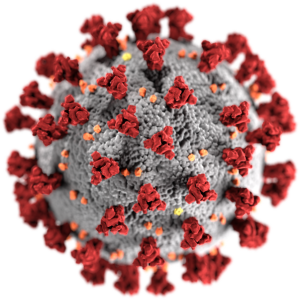
CDC/ Alissa Eckert, MS; Dan Higgins, MAM, Public domain, via Wikimedia Commons
Nearly two months after it commenced a stringent lockdown, Israel appears to be turning a corner in the fight against the coronavirus.
The number of new cases over 24-hour periods has consistently been below 200 since the start of last week. On Sunday night, Israel registered only 29 new cases – the lowest in six weeks – and on Tuesday night that fell further to 25.
The number of people on ventilators in Israel has also fallen to 70. More than half of those diagnosed with the virus in Israel have now recovered.
In all, 16,314 people have so far tested positive for the coronavirus and 238 people have died.
In the West Bank, 336 people tested positive for the virus and two have died. In the Gaza Strip, 17 people were diagnosed and 12 have recovered.
On Monday evening, the Israeli government announced a major scaling-back of restrictions in the country. The ban on people travelling more than 100 metres from their home for non-essential activities is being lifted. Announcing the move, the Israeli prime minister, Benjamin Netanyahu, said: “I know you’ve been waiting for this for a while.”
For the first time in six weeks, visits to immediate family members – including grandparents – will again be permitted, although social distancing is being strongly advised on visits to elderly relatives.
Also being allowed are gatherings of up to 20 people in open areas. The limit will be raised to 50 people on 17 May and removed altogether on 14 June “assuming that no red light is lit,” Netanyahu said. If they are held in open areas, weddings and funerals can be attended by up to 50 people.
Shopping malls, gym and outdoor markets will be allowed to reopen on Thursday, but will be required to adhere to certain restrictions. Universities and colleges are expected to reopen on 14 June. Some Israeli pupils are already back at school and all will be able to return to class by the end of the month. Restrictions are also being eased on sports and leisure. Libraries, hotels, guesthouses, nature reserves, heritage sites, national parks and zoos have also been told they may reopen. Domestic flights are expected to resume within weeks, although international flights remain barred. Last week, the government began the process of easing restrictions.
Netanyahu warned, however, that social distancing must be adhered to and that restrictions will be reimposed if another outbreak of the virus occurs.
Israel is also to begin a nationwide serological test of 100,000 people to see how widely the virus has spread across its population and how vulnerable it may be to a new wave of the contagion. The survey is one of the largest efforts yet to determine the prevalence of antibodies to the virus and is similar to an antibody test that Germany has announced.
International comparisons
The number of Israelis who have lost their lives to the virus is below the international average. According to the Worldometer coronavirus tracker, there have been 27 deaths/ million of population in Israel. The international average is 31.9. By comparison, that in the UK is 419 and 540 in Spain.
The figures, wrote David Horovitz of the Times of Israel, “puts us at about 50th in the world, and better than the global average. (With many countries providing less reliable statistics, furthermore, Israel’s global ranking is actually almost certainly considerably better.) Certainly not peerless, but striking nonetheless”.
The number of deaths in Israel – which has a population of 9.2 million people – compared to similar-sized countries is revealing. Sweden, which has adopted far less tough lockdown measures than other European counties, has a population of 10 million but has seen over 2,600 deaths. Belgium, which has seen nearly 8,000 casualties, has a population of 11 million. And Austria, with its 8.5 million population, has lost 600 people.
When pressed on whether its measures have been too tough, Israeli health officials have reached for these comparisons. Last month, the director-general of the Health Ministry was asked if Israel had over-reacted. “I don’t think so. There are enough control groups — look at Belgium,” he responded.
Asked to explain the relatively low number of fatalities in the country, Professor Yehuda Carmeli, one of the medical professionals leading the Israeli Health Ministry’s response to the coronavirus pandemic, suggested: “Mostly because the outbreak was handled very well by decision-makers. We shut down many activities early and we protected high-risk populations. When you look at the number of cases in Israel, it’s relatively low per capita, but still not as low as the mortality rate. And the reason for the low mortality rate is that although there was a lot of criticism about how many tests were done, Israel is among the leading countries in the world in testing people. We do a lot of tests so we detect a lot.”
Carmeli also pointed to demographic factors in terms of who the virus had affected: “It’s because most of our affected population are young people, and they have a very low mortality rate. If you look at the distribution of sick people in Israel, fewer than five percent are over the age of 80. That’s the age where you start to see very high mortality rates. And in Israel, the population over 70 and 80 was quite well protected.”
Economic cost
However, in Israel and the West Bank, the crisis has taken a high economic toll.
The jobless rate jumped from four percent in early March to an unprecedented 26 percent in mid-April. For the first time since 2002, growth this year is expected to be negative, at minus 5.4 percent, the Finance Ministry has warned. Growth of three percent (down from 3.3 percent in 2019) had been previously forecast by the ministry. However, after the government began to loosen the lockdown of businesses last week, there were some early positive indications that the economy might be beginning its slow climb-back to recovery on Monday when, for the first time since the onset of the crisis, the National Employment Service reported the number of people who returned to work over the previous 24 hours was significantly higher than those who had registered as unemployed.
Like Israel, the Palestinian Authority moved swiftly and effectively to combat the virus: closing schools, declaring a state of emergency and placing tight limits on movement within the West Bank. The PA’s performance has given a big boost to its previously low approval ratings among Palestinians.
But that has also come at a high economic price. The PA had lost over 50 percent of its revenue and been forced to ask Israel for help and to borrow huge sums from Palestinian banks. It has been unable to pay the full salaries of its public sector employees. Last month, the World Bank warned that the Palestinian economy could contract by 2.5 percent in 2020 if the outbreak was brought under control within four months. If not, it predicted, Palestinian GDP could shrink by more than seven percent this year.
Unemployment in the West Bank was high before the crisis hit and about 140,000 West Bank Palestinians normally cross the border to work in Israel every day. However, in March, Israel banned commuting and required workers to remain in Israel for at least two months, with their employers obliged to find accommodation for them. Around 50,000 Palestinians chose to do so. That number dropped in late March when the PA ordered Palestinian workers to return from Israel to the West Bank and self-quarantine. Given that the Palestinian economy is dominated by the public sector, the PA will be keen for workers to return to Israel as soon as it is safe to do so. Israel, which relies on Palestinian workers, especially in sectors such as agriculture and construction, will be equally keen.
Israeli-Palestinian cooperation
Although not free of tensions, there have also been positive signs of cooperation between Israel and the PA, which the UN’s Middle East envoy Nickolay Mladenov has praised as “excellent.”
In the early days of the crisis, Israel and the PA established a virtual joint operations room to coordinate their response. The existing mechanisms which coordinate civilian activities in the West Bank —the Israeli Coordinator of Government Activities in the Territories (COGAT) and the Palestinian Ministry of Civilian Affairs—was also enhanced with representatives from each side’s health ministry and other institutions added to the structure.
Israel transferred several thousand testing kits and tens of thousands of masks and other protective gear to the PA and organised joint training sessions for Israeli and Palestinian medical personnel and disseminated relevant information to the Palestinian public on how to cope with the virus.
Israel has also sought to help alleviate the financial strain the PA is under, releasing an extra $33.5 million on top of the regular monthly transfers of indirect Palestinian tax funds that it collects for the PA.
However, while it has worked closely with the Jewish state behind the scenes, the PA has also publicly gone on the attack and accused Israel of intentionally spreading the coronavirus in the West Bank. The PA Health Ministry lists on its website the cause of the confirmed Palestinian coronavirus cases in the West Bank as “the occupation state”. After Israel accused the PA of incitement, the Palestinian prime minister, Mohammad Shtayyeh, last month responded: “We will not bow to blackmail in any form.” The PA charges stem from the fact that, according to Israel’s Channel 12, the source of contagion of nearly 75 percent of cases that have tested positive for coronavirus in the PA has been traced to Palestinian workers employed in Israel. PA government spokesman Ibrahim Melhem even went so far as to claim: “They [the Israelis] are not only exporting [the virus]. They are agents of this virus.”
That language was in marked contrast to the tone set by Israel’s president, Reuven Rivlin, and the PA president, Mahmoud Abbas, when they spoke by phone in March. “The world is dealing with a crisis that does not distinguish between people or where they live,” Rivlin told Abbas. “The cooperation between us is vital to ensure the health of both Israelis and Palestinians. Our ability to work together in times of crisis is also testament to our ability to work together in the future for the good of us all.”


